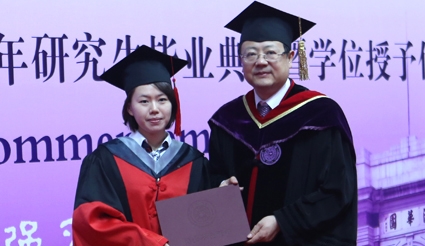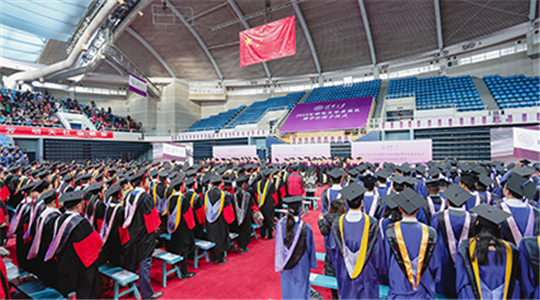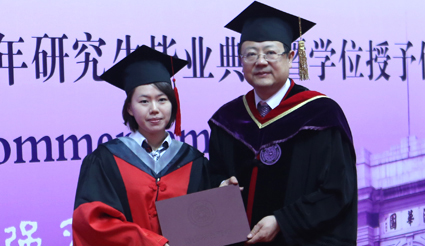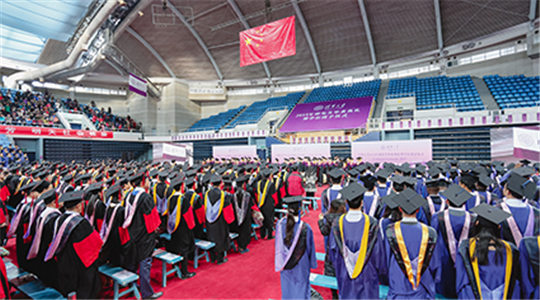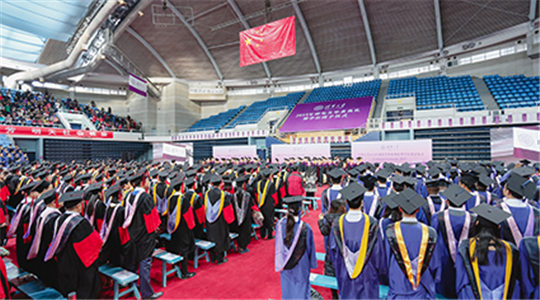
当前课程知识点:学术英语 > Module2 Academic Reading > Extended reading > html
Creative People Physically See and Process the World Differently
Alice Klein
1 If you’re the kind of person who relishes adventure, you may literally see the world differently. People who are open to new experiences can take in more visual information than other people and combine it in unique ways. This may explain why they tend to be particularly creative.
2 Openness to experience is one of the “big five” traits often used to describe personality. It is characterized by curiosity, creativity and an interest in exploring new things. Open people tend to do well at tasks that test our ability to come up with creative ideas, such as imagining new uses for everyday objects like bricks, mugs or table tennis balls.
3 There’s some evidence that people with a greater degree of openness also have better visual awareness. For example, when focusing on letters moving on a screen, they are more likely to notice a grey square appearing elsewhere on the display.
4 Now Anna Antinori at the University of Melbourne in Australia and her team are showing that people who score more highly when it comes to the openness trait “see” more possibilities. “They seem to have a more flexible gate for the visual information that breaks through into their consciousness,” Antinori says.
5 Patchwork pictures
Antinori and her colleagues asked 123 university students to complete a binocular rivalry test, in which they simultaneously saw a red image with one eye and a green image with the other eye for 2 minutes.
6 Usually, the brain can only perceive one image at a time, and most participants reported seeing the image flip between red and green. But some subjects saw the two images fused into a patchwork of red and green — a phenomenon known as “mixed percept”.
7 The higher the participants scored for openness on a personality questionnaire, the more they experienced this mixed perception.
8 “When you present open people with the binocular rivalry dilemma, their brains are able to flexibly engage with less conventional solutions,” Antinori says. “We believe this is the first empirical evidence that they have different visual experiences to the average individual.”
9 In contrast, the other four major personality traits — extroversion, neuroticism, agreeableness and conscientiousness — weren’t significantly linked to experiencing this mixed perception.
10 Mind expanding
The results could explain why people with a high degree of openness tend to be more creative and innovative, Antinori says. “When they come up with all these crazy new uses for bricks, it might be because they really perceive the world differently,” she says.
11 The findings also hint at why extremely open people are more prone to paranoia and delusions, says Niko Tiliopoulos at the University of Sydney, Australia. “At those levels of openness, people may actually see reality differently,” he says. “For example, they may ‘see’ spirits, or misinterpret interpersonal or other signals.”
12 According to Antinori, there are similarities between high levels of openness and the experience of taking magic mushrooms. Previous work by her team has found that psilocybin — a hallucinogenic compound in magic mushrooms[1] — increases a person’s openness scores in a personality questionnaire, and their experience of mixed percept in binocular rivalry tests.
13 The team has also found that some forms of meditation can increase mixed image perception in binocular rivalry tests.
14 Antinori next wants to see if similar neural processes are involved in mixed perception, creative thinking and the shifts in visual perception caused by psilocybin and meditation. “It seems that openness alters the filter of consciousness, and we’d like to know how,” she says.
[1]
-Welcome to EAP course 欢迎学习“学术英语课程”
-Extended reading Unit 1
--html
--html
-Extended reading exercises
-1.1 Introduction to the module of listening skills 模块介绍
-1.2 Predicting the content 预测听力内容
--Video
--html
--图片全屏
--Audio
--html
--图片全屏
--html
--外部链接
-Module1 Listening--1.2
-1.3 Understanding main ideas: key words 抓住关键词理解大意
--Video
--html
--Video
--外部链接
-Module1 Listening--1.3
-1.4 Understanding supporting evidence (I): explicit means 理解支持性证据 (I):显性证据
--Video
--html
--图片全屏
--Audio
--外部链接
-Module1 Listening--1.4
-1.5 Understanding supporting evidence (II): implicit means 理解支持性证据 (II):隐性证据
--Video
--html
--Video
-Module1 Listening--1.5
-1.6 Recognizing rhetorical questions 辨别修辞问句
--Video
--html
--Video
-Module1 Listening——1.6
-1.7 Understanding the organization of a lecture (I): chronological order 理解讲座结构 (I):时间顺序
--Video
--html
--Video
-Module1 Listening--1.7
-1.8 Understanding the organization of a lecture (II): categorization 理解讲座结构 (II):归类
--Video
--html
--Video
-Module1 Listening--1.8
-1.9 Handling unfamiliar words 应对不熟悉词汇
--Video
--html
--Video
--html
-Module1 Listening--1.9
-1.10 Understanding vocabulary from the context 从上下文理解词汇
--Video
--html
--Video
--html
-Module1 Listening--1.10
-1.11 Focusing on numbers & statistics 注意数字与数据
--Video
--html
--Video
-Module1 Listening--1.11
-1.12 Recognizing analogy 辨别类比
--Video
--html
--Video
-Module1 Listening--1.12
-1.13 Recognizing signposting language (I): contrast 辨别指示性语言 (I):对比
--Video
--html
--Video
-Module1 Listening--1.13
-1.14 Recognizing signposting language (II): consequence 辨别指示性语言 (II):结果
--Video
--html
--Video
-Module1 Listening--1.14
-1.15 Recognizing signposting language (III): presenting factual information 辨别指示性语言 (III):陈述事实信息
--Video
--html
--Video
-Module1 Listening--1.15
-1.16 Note-taking: numbers & diagrams 记笔记:数字和图表
--Video
--html
--Video
--html
--Video
-Module1 Listening--1.16
-1.17 Summary to the module of listening skills 模块总结
--Video
-Module test
--Video
--html
--Module1 Academic Listening--Module test
-Extended reading
--html
--html
-Module1 Extended reading
-2.1 Introduction to the module of reading skills 模块介绍
--Video
-Module2 Reading--2.1
-2.2 Surveying an article 浏览文章
--Video
-Module2 Reading--2.2
-2.3 Skimming and scanning 查读和略读
--Video
-Module2 Reading--2.3
-2.4 Recognizing text organization / structure 识别文章结构
--Video
-Module2 Reading--2.4
-2.5 Identifying the author's evaluation 识别作者评价
--Video
-Module2 Reading--2.5
-2.6 Identifying the thesis statement 识别文章中心句
--Video
-Module2 Reading--2.6
-2.7 Increasing reading speed 提高阅读速度
--Video
-Module2 Reading--2.7
-Module test 2-1
--html
--外部链接
--html
--html
--图片全屏
--html
--html
--外部链接
-Module2 Academic Reading--Module test 2-1
-2.8 Guessing unfamiliar words from context 从上下文猜测词意
--Video
-Module2 Reading--2.8
-2.9 Recognizing topic sentence and supporting evidence 识别主题句和支持性证据
--Video
-Module2 Reading--2.9
-2.10 Understanding quotations 理解引语
--Video
-Module2 Reading--2.10
-2.11 Using questions for effective reading 使用问句促进阅读
--Video
-Module2 Reading--2.11
-2.12 Recognizing classification 识别分类
--Video
-Module2 Reading--2.12
-2.13 Recognizing comparison and contrast 识别比较和对比
--Video
-Module2 Reading--2.13
-2.14 Recognizing cause and effect 识别因果关系
--Video
-Module2 Reading--2.14
-2.15 Annotating the text 标记文章
--Video
-Module2 Reading--2.15
-2.16 Summary to the module of reading skills 模块总结
--Video
-Module test 2-2
--html
--外部链接
--html
--外部链接
--html
--外部链接
--Module2 Academic Reading--Module test 2-2
-Extended reading
--html
--html
-Module2 Extended reading
-3.1 Introduction to the module of speaking skills 模块介绍
--Video
--html
-Module3 Speaking--3.1
-3.2 Preparing for a presentation 准备陈述报告
--Video
-Module3 Speaking--3.2
-3.3 Opening a presentation 开始陈述报告
--Video
-Module3 Speaking--3.3
-3.4 Presenting the main body 陈述报告主体
--Video
-Module3 Speaking--3.4
-3.5 Concluding the presentation 结束陈述报告
--Video
-Module3 Speaking--3.5
-3.6 Evaluating students' presentation 评价学生的陈述报告
--Video
-Module3 Speaking--3.6
-Module test 3-1
--html
-Module3 Academic Speaking--Module test 3-1
-3.7 Opening a discussion; Agreeing and disagreeing 开始讨论;表达赞同与不赞同
--Video
-Module3 Speaking--3.7
-3.8 Keeping a discussion going; Discussing the pros and cons 保持讨论;支持与反对
--Video
-Module3 Speaking--3.8
-3.9 Interrupting politely; Asking for clarification or confirmation 客气地打断讨论;要求对方阐释或确认
--Video
-Module3 Speaking--3.9
-3.10 Expressing an opinion; Supporting an opinion 表达观点;支撑观点
--Video
--Video
-Module3 Speaking--3.10
-3.11 Evaluating students' group discussion 评价学生的讨论
--Video
-Module3 Speaking--3.11
-3.12 Summary to the module of speaking skills 模块总结
--Video
-Module3 Speaking--3.12
-Module test 3-2
--Module3 Academic Speaking--Module test 3-2
-Extended reading
--html
--html
--Module3 Extended reading
-4.1 Introduction to the module of writing skills 模块介绍
--Video
-Module4 Writing--4.1
-4.2 Writing an introduction 写文章开头
--Video
-Module4 Writing--4.2
-4.3 Writing a thesis statement 写文章中心句
--Video
-Module4 Writing--4.3
-4.4 Writing the main body 写文章主体
--Video
-Module4 Writing--4.4
-4.5 Writing a body paragraph 写主体段落
--Video
-Module4 Writing--4.5
-4.6 Writing a conclusion 写文章结论
--Video
-Module4 Writing--4.6
-4.7 Evaluating students' writing (structure) 评价学生的写作(结构方面)
--Video
-Module4 Writing--4.7
-Module test 2-1
--Module4 Academic Writing--Module test 2-1
-4.8 Writing in formal languge 用正式文体写作
--Video
--Video
-Module4 Writing--4.8
-4.9 Writing in cautious language 用谨慎的话语写作
--Video
--Video
-Module4 Writing--4.9
-4.10 Writing in efficient language 用简练的话语写作
--Video
--Video
-Module4 Writing--4.10
-4.11 Avoiding plagiarism (quoting, paraphrasing and summarizing) 避免学术抄袭(引用,改写,总结)
--Video
-Module4 Writing--4.11
-4.12 Avoiding plagiarism (acknowledging sources) 避免学术抄袭(注明出处)
--Video
-Module4 Writing--4.12
-4.13 Summary to the module of writing skills
--Video
-Module4 Writing--4.13
-Module test 2-2
--Module4 Academic Writing--Module test 2-2
-Extended reading
--html
--html
--Module4 Extended readinging
-5.1 Introduction to the module of translating skills
--Video
-Module5 Translating--5.1
-5.2 What is translation 什么是翻译
--Video
-5.3 How to get ready for translation? 怎样做好翻译的准备?
--Video
-Module5 Translating--5.3
-5.4 Word-for-word translation 逐字翻译
--Video
-Module5 Translating--5.4
-5.5 Diction (I): grammatical clues 词意的选择(I):语法线索
--Video
-Module5 Translating--5.5
-5.6 Diction (II): collocation clues 词意的选择(I):词汇搭配线索
--Video
-Module5 Translating--5.6
-5.7 Omission (I): leaving out unnecessary prepositions and conjunctions 省略法(I):删减不必要的介词和连词
--Video
-Module5 Academic Translating--5.7 Omissio
-5.8 Omission (II): leaving out unnecessary articles 省略法(II):删减不必要的冠词
--Video
-Module5 Translating--5.8
-5.9 Conversion (I): translating nouns as adjectives or verbs 词性转换(I):名词翻为形容词或动词
--Video
-Module5 Translating--5.9
-5.10 Conversion (II): translating verbs as nouns or adverbs 词性转换(II):动词翻为名词或副词
--Video
-Module5 Translating--5.10
-5.11 Addition (I): adding nouns 增词法(I):增加名词
--Video
-5.12 Addition (II): adding adjectives or adverbs 增词法(II):增加形容词或副词
--Video
-Module5 Translating--5.12
-5.13 Addition (III): adding verbs 增词法(III):增加动词
--Video
-Module5 Translating--5.13
-5.14 Addition (IV)): adding conjunctions 增词法(IV):增加连词
--Video
-Module5 Translating--5.14
-5.15 Translating relative clauses (I): as pre-modifiers 翻译关系从句(I):作为前置修饰语
--Video
-Module5 Translating--5.15
-5.16 Translating relative clauses (II): as post-modifiers 翻译关系从句(II):作为后置修饰语
--Video
-Module5 Translating--5.16
-5.17 Translating relative clauses (III): merging 翻译关系从句(I):合并
--Video
-Module5 Translating--5.17
-5.18 Translating relative clauses (IV): dividing 翻译关系从句(I):分裂
--Video
-Module5 Translating--5.18
-5.19 Translating passive constructions (I): as active constructions 翻译被动结构(I):翻为主动结构
--Video
-Module5 Translating--5.19
-5.20 Translating passive constructions (II): as passive constructions 翻译被动结构(I):翻为被动结构
--Video
-Module5 Translating--5.20
-5.21 Evaluating students' translation 评价学生的翻译作品
--Video
-Module5 Translating--5.21
-5.22 Summary to the module of translating skills 模块总结
--Video
-Module5 Translating--5.22
-Module test
--Module5 Academic Translating--Module test
-Extended reading
--html
--html
-Module5 Extended reading



